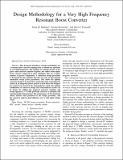| dc.contributor.author | Burkhart, Justin M. | |
| dc.contributor.author | Korsunsky, Roman | |
| dc.contributor.author | Perreault, David J. | |
| dc.date.accessioned | 2014-05-22T17:17:12Z | |
| dc.date.available | 2014-05-22T17:17:12Z | |
| dc.date.issued | 2013-04 | |
| dc.date.submitted | 2012-03 | |
| dc.identifier.issn | 0885-8993 | |
| dc.identifier.issn | 1941-0107 | |
| dc.identifier.uri | http://hdl.handle.net/1721.1/87098 | |
| dc.description.abstract | This paper introduces a design methodology for a resonant boost converter topology that is suitable for operation at very high frequencies. The topology we examine features a low parts count and fast transient response, but suffers from higher device stresses compared to other topologies that use a larger number of passive components. A numerical design procedure is developed for this topology that does not rely on time-domain simulation sweeps across parameters. This allows the optimal converter design to be found for a particular main semiconductor switch. If an integrated power process is used where the designer has control over layout of the semiconductor switch, the optimal combination of converter design and semiconductor layout can be found. To validate the proposed converter topology and design approach, a 75-MHz prototype converter is designed and experimentally demonstrated. The performance of the prototype closely matches that predicted by the design procedure, and the converter achieves good efficiency over a wide input voltage range. | en_US |
| dc.language.iso | en_US | |
| dc.publisher | Institute of Electrical and Electronics Engineers (IEEE) | en_US |
| dc.relation.isversionof | http://dx.doi.org/10.1109/TPEL.2012.2202128 | en_US |
| dc.rights | Creative Commons Attribution-Noncommercial-Share Alike | en_US |
| dc.rights.uri | http://creativecommons.org/licenses/by-nc-sa/4.0/ | en_US |
| dc.source | Vabulas | en_US |
| dc.title | Design Methodology for a Very High Frequency Resonant Boost Converter | en_US |
| dc.type | Article | en_US |
| dc.identifier.citation | Burkhart, Justin M., Roman Korsunsky, and David J. Perreault. “Design Methodology for a Very High Frequency Resonant Boost Converter.” IEEE Trans. Power Electron. 28, no. 4 (n.d.): 1929–1937. | en_US |
| dc.contributor.department | Massachusetts Institute of Technology. Department of Electrical Engineering and Computer Science | en_US |
| dc.contributor.department | Massachusetts Institute of Technology. Laboratory for Electromagnetic and Electronic Systems | en_US |
| dc.contributor.approver | Perreault, David J. | en_US |
| dc.contributor.mitauthor | Burkhart, Justin M. | en_US |
| dc.contributor.mitauthor | Perreault, David J. | en_US |
| dc.relation.journal | IEEE Transactions on Power Electronics | en_US |
| dc.eprint.version | Author's final manuscript | en_US |
| dc.type.uri | http://purl.org/eprint/type/JournalArticle | en_US |
| eprint.status | http://purl.org/eprint/status/PeerReviewed | en_US |
| dspace.orderedauthors | Burkhart, Justin M.; Korsunsky, Roman; Perreault, David J. | en_US |
| dc.identifier.orcid | https://orcid.org/0000-0002-0746-6191 | |
| mit.license | OPEN_ACCESS_POLICY | en_US |
| mit.metadata.status | Complete | |
